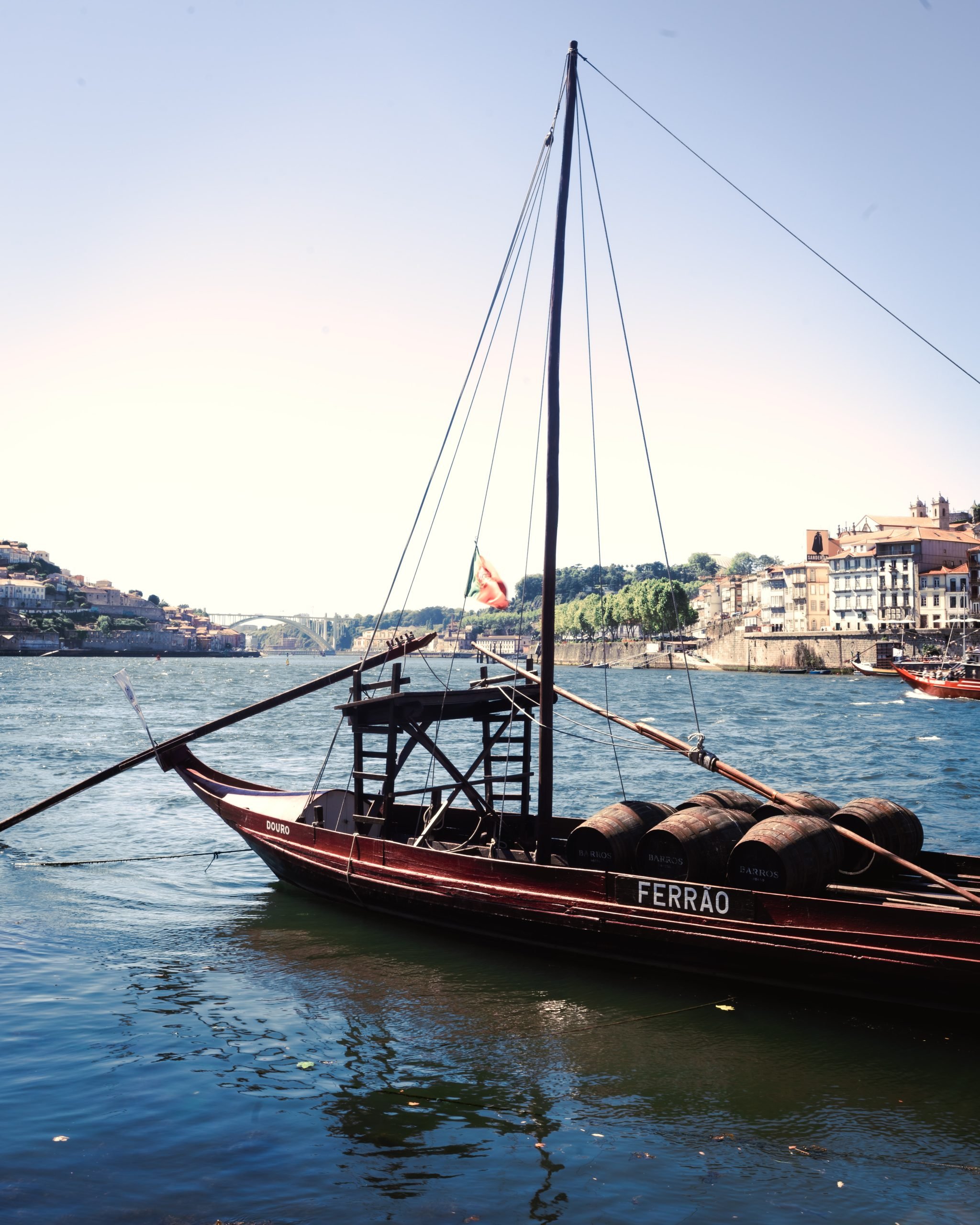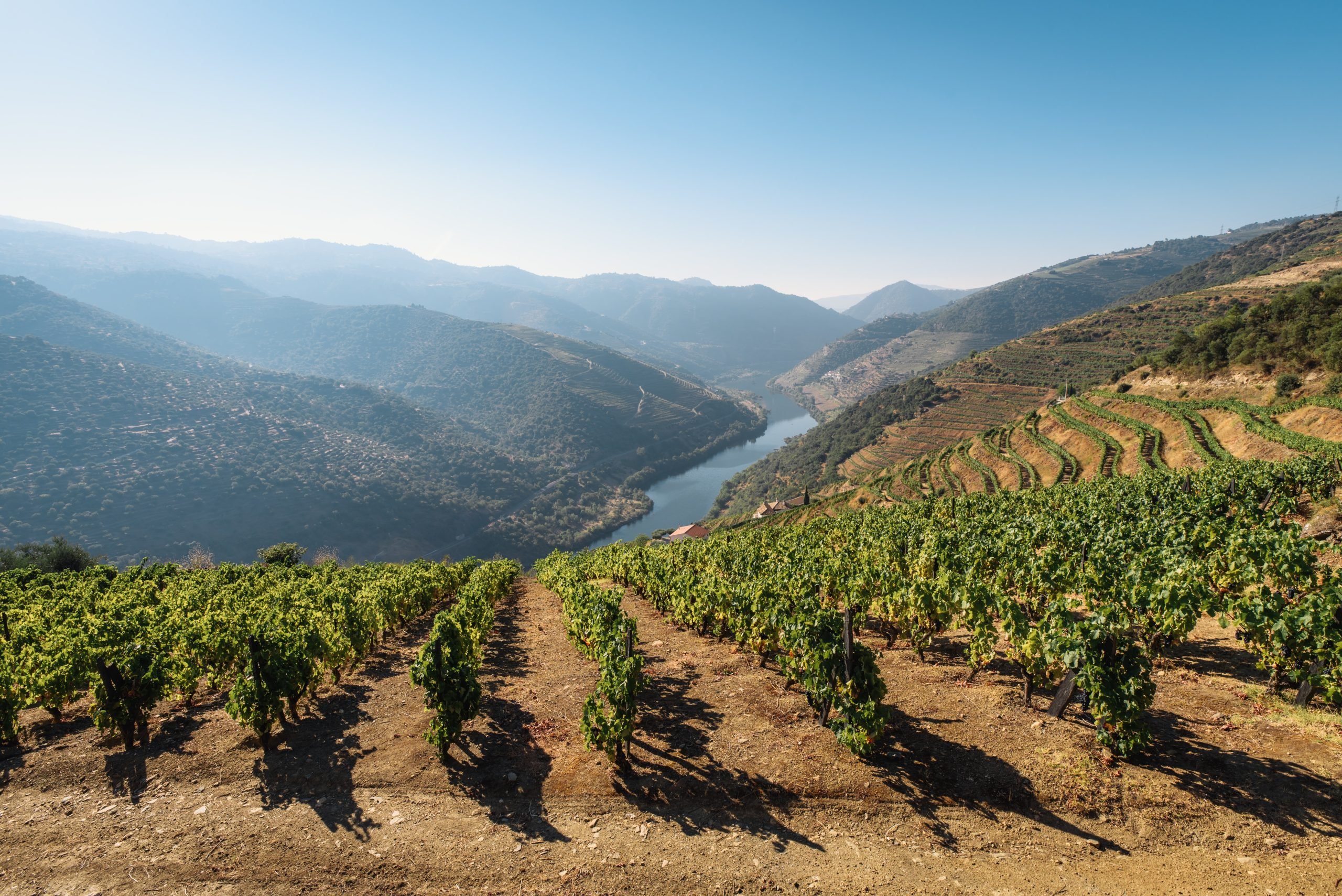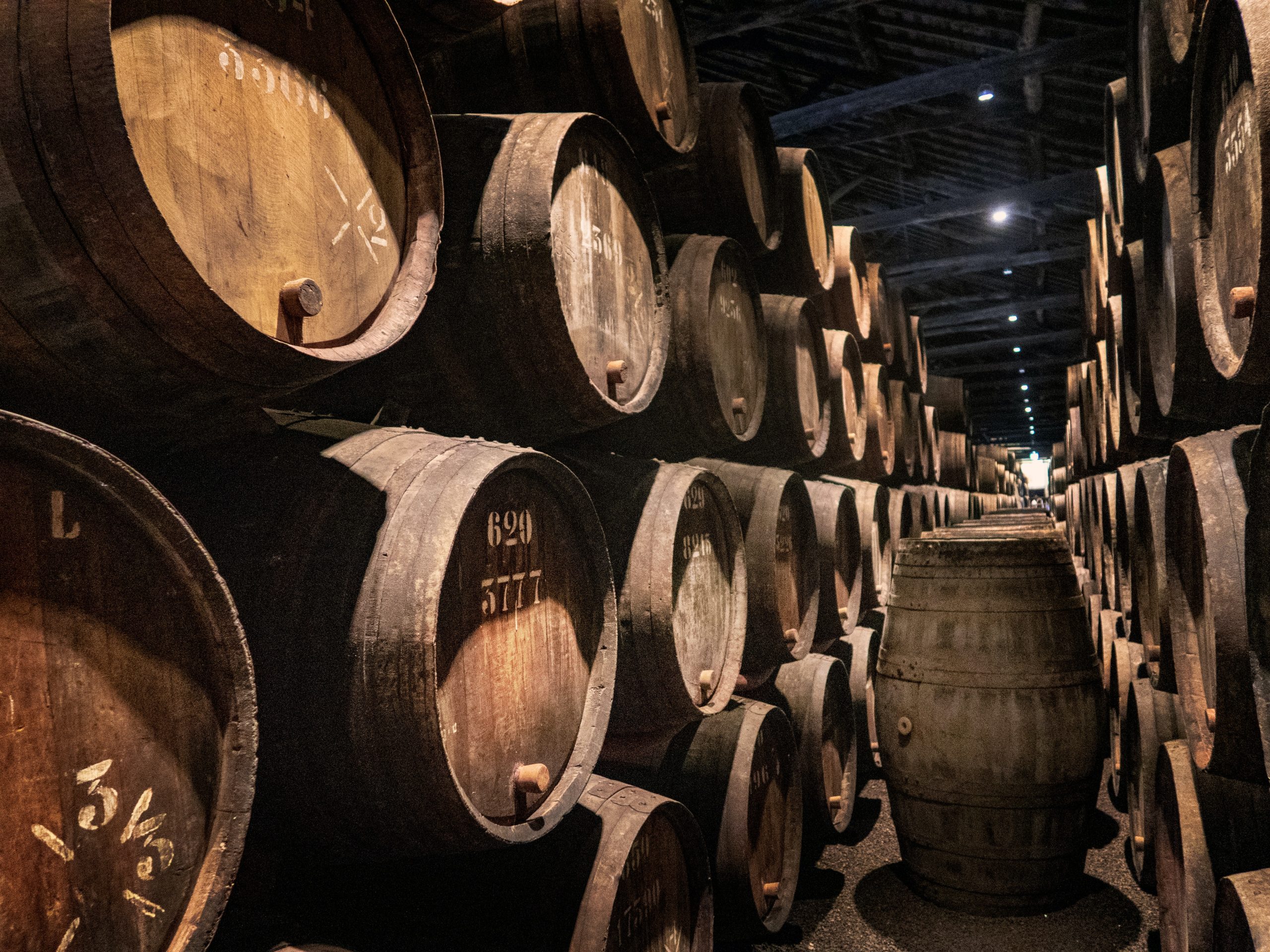The famous wine that enchanted the world (especially the British) is here to enchant YOU! This sweet (but strong) wine is perfect for the end of a good dinner while relaxing and having a wonderful chat.
Port wine is specific to the Douro region in the North of Portugal and was what made this region famous. It’s a fortified wine, usually a sweet red wine but also coming in dry, semi-dry, and white (and now, even rosé).
Nowadays, due to how famous the wine got, there are many port-inspired fortified wines outside Portugal, but under EU law only Portuguese wines from the Douro demarcation region are allowed to be labeled as “Port”, as a way to protect the traditional and economic importance of this wine.
The difference from other non-fortified wines is its richness, sweetness, heaviness and its higher alcohol percentage, made by the addition of distilled grape spirits into the wine and the halt fermentation before all the sugar is turned into alcohol. This creates a wine that has usually 19-20% alcohol content.
It’s a very famous wine all over the world, especially in the UK and the English-speaking world. It’s usually served as a digestif, this is, after meals to accompany dessert, usually cheese, nuts, or chocolate. However, tawny and white port is many times served as an apéritif, this is, before meals.
History of Port Wine
Wine in this region has been cultivated for a very long time, with grape seeds being found in archaeological sites there and evidence for wine production dating back to the 3rd and 4th centuries.
As for Port wine specifically, mentions are dating as far back as 1675. However, with the demarcation of the Port wine zone, in 1756, Port wine started to have larger importance on the country’s economy and culture.
In that year, the ‘Companhia Geral da Agricultura das Vinhas do Alto Douro’ (General Company of Viticulture of the Upper Douro) was founded to guarantee the quality and fair pricing of Port wine in all of the region. The C.G.A.V.A.D., as it was known, also regulated which Port wine could be exported and which one would be for internal consumption, and also managed the demarcation of the protected area.
The name of the wine is thought to have been attributed in the second half of the 17th century and it refers to the city of Porto (or Oporto), on the mouth of the Douro River. This was because it was there that the product was brought to and sold to the national and international market, even though it was not produced there.
Actually, it was brought to Gaia, the city on the other side of the Douro River from Porto, but Porto was the bigger and main city.
In Portuguese, the name of the wine is “Vinho do Porto”, which literally means “Wine of Porto (Oporto)”. Due to the similarity and to the fact that the word “Port” in Portuguese is the same word as the name of the city (“Porto”), the name stuck.
The English are known to be particular fans of the Port wine, with The Queen Mother (mother of current Queen Elizabeth II) being said to have a glass of port at the end of her lunch. However, the story of England and this wine is much older than that.
It is said that in 1678, two representatives of a Liverpool wine merchant were sent to Viana do Castelo, a city north of Porto, to learn about the local wine trade. The two merchants went on a vacation to the Douro region and, while in Lamego, the local Abbot gave them what they thought was a very sweetish and smooth wine, that had been fortified with a distilled spirit. The merchants loved it so much that they bought the Abbot’s entire lot and sent it back to England, opening England’s doors to this new wine.
A few years later, in 1703, the wine started to truly get popular with the Methuen Treaty. At the time, The Second Hundred Years’ War was happening, between Great Britain and France. This meant that England was deprived from importing French wine. With the treaty, English merchants could import Port wine at a low duty tax and this smooth fortified wine appealed to the English public.
The influence that the British had on the trade of Port can be seen by the Port brands’ own names: Croft, Graham, Sandeman, Taylor’s and Offley being amongst the best known and the main ones that you can see from Porto when you look to the other side of the river, but many, many more exist! Other nationalities also got involved in the trade, with Dutch and German shippers also existing, such as Niepoort and Burmester.
But don’t think that the Portuguese didn’t get a piece of the pie! The Ferreira and Quinta do Crasto are among the best Port houses as well, and it became an integral part of Portuguese culture and pride, as well as an important part of the country’s economy.
But the British didn’t just have their hand in Port production, the Port also gained its space in British culture. It was used in the past as a medicine, with William Pitt, a British Prime Minister, saying it was given to him as a remedy for gout when he was younger. This is paradoxical since the Prime Minister then began to drink a bottle a day when he was 14 and heavy alcohol consumption is known to aggravate gout. In Anthony Trollope’s novels, elderly ladies usually drank Port wine, excusing it as medicinal.
Port Wine Transport

Part of the culture it brought to Portugal was precisely its mode of transportation. The wine was produced in the Douro valley, not in Porto or Gaia, the places where it is usually associated with and where all the port lodges (or cellars) are.
To get there, where it would then be sold and exported (Gaia was the only place from where the wine could be exported until 1986), it would be transported down the Douro River in the famous ‘rabelos’, flat-bottom boats that only transported Port wine.
This traditional and cultural trip ended when in the 1950s and 1960s, the government allowed for the construction of hydroelectric power dams throughout the river, making the trip impossible in some cases.
Nowadays, the wine is transported to Gaia and Porto with trucks, and the ‘rabelos’ are used for racing and touristic tours. Some tours do part of the trip upstream until you get to some vineyards but don’t transport wine anymore.
Port Region – The Douro

The Port region is the Douro wine region (which we’ve covered in another article). It was demarcated in 1756, becoming the third wine region in the whole world to have a formal legal demarcation zone, after the Tokaj-Hegyalja region in Hungary and Chianti in Italy, in 1730 and 1716 respectively. More recently, the region became a UNESCO World Heritage Site in 2001.
This region in the north of Portugal, going through the Douro River and its tributaries valleys and going to the border with Spain, has its own microclimate that is great not only for the production of grapes but also for olives and almonds.
The region around the towns of Pinhão and São João da Pesqueira is considered to be the center of the Port wine production and is known for its beautiful views and wine farms standing right next to the Douro, on “terraces” that seem to make huge stairs right into the River.
Production of Port Wine

The Port wine’s production is also peculiar and different from other “normal” wines. First, it has to be produced from grapes grown and processed in the Douro wine region, a specific demarcated geographical region recognized throughout the world.
Then, the wine, after being produced, is fortified. This means that ‘aguardente’ is added to it, a very strong (anywhere from 25 to 54% alcohol content) spirit made out of grapes as well that you can find throughout Portugal. The addition increases the alcohol content of the wine and stops the fermentation process, leaving some sugar still.
The wine is then transported to be stored in barrels (traditionally in lodges, in Gaia), where it will be aged for as long as the intended style of Port wine is. After it, it will be bottled, sometimes aging a little bit more inside the bottle, depending on the style.
Styles of Port Wine
- Ruby: this is the most produced and least-pricey Port. It’s made from red grapes and is usually aged in a steel or concrete tank to prevent oxidation and preserve its fruitiness and bright color. In the end, it’s fined and cold filtered before being bottled and it doesn’t improve with age.
- Tawny: very sweet, golden-brown Port made from red grapes. It’s at least aged for 3 years (with Reserve Tawny being aged for around 7 and anything over that being stated on the label) and it has sort of “nutty” flavors, due to its exposure to oxygen while in the barrel.
- White: made from white wine grapes, it can be anything from dry to sweet.
- White Colheita: produced from a single grape harvest and aged in huge tanks to get a pale yellow color.
- White Reserve: has to be at least 7 years aging.
- Rosé: this is a new style, first released in 2008 by Croft. It’s made like a rosé wine, with its exposure to grape skin being limited as to give it the rosé color.
- Vintage: made from grapes from a ‘vintage year’, sourced from different farms (or ‘quintas’) and aged in barrels or stainless steel for up to 2.5 years. After this, it is bottled and it ages another 10-40 years in the bottle, to gain complexity as the grape solids slowly decompose there.
- Late Bottled Vintage (LBV): a Port that spent 4-6 years barrel-aging, when it matured and settles down. After this, it can be bottled and it is ready to drink since it doesn’t need to be decanted. It is cheaper than Vintage Port.
- Crusted: sometimes also called “Vintage Character Port”, is a wine that spends at least 4 years aging on a wood barrel. It’s bottled unfiltered and cellared for 3 more years before being sold. Its name is because it creates a crust on the bottle, from not being filtered. Sometimes it can take more than 10 years for it to form, showing that the wine will keep improving with age.
- Garrafeira: 3-6 years aged in wood and at least another 8 years in glass demijohns (large, narrow-necked bottles) before being bottled and sold. These days, it is only produced by Niepoort and it is described as tasting like bacon (yes, bacon), because of the oils that it can create across the glass during its second phase of maturation.
Port Wine Suggestions: Best Port Wine
If you are looking to buy a Port wine, there are many varieties to choose from, as you saw. As for the brand, these are the most known ones and the ones you can buy knowing you will get a quality wine:
- Dow
- Graham’s
- Ferreira
- Quinta do Vallado
- Taylor’s
- Quinta da Pacheca
- Offley
- Niepoort
- Sandeman
However, there are many more quality wines and know that it will always depend on the style of Port and the year of production, so just try it out and see what suits you better! I hope you enjoy this wine as much as the British do and don’t forget to have your “medicinal” glass after dinner 😉
3 Best Port Wine Tasting Tours
1. Graham’s Port Lodge Tour with Wine Tasting & Pairings
This tour in Vila Nova de Gaia allows you to explore the 1890 Graham’s Port Lodge and learn about the production of Port wine, as well as enjoy a premium wine tasting with food pairings, such as chocolate and cheese. You will also get a great view of Porto and the two-tier bridge.
2. Guided Tour of Pocas Port Wine Cellar with Tasting
Discover a family-owned Port wine cellar founded in 1918 on this 1-hour guided tour, where you will learn about wines that have been maturing for over 100 years. You will get to taste some White Port (Dry, Medium Dry, or Sweet), Late Bottled Vintage (LBV), and old Tawny Port.
3. Magic Train Tour and Port Wine Tastings
The fun Magic Train takes you on a 2-hour Port wine tasting tour of Porto. Visit one of the oldest wine cellars in Portugal, stop for 2 Port wine tastings, and get to see some of the best monuments in Porto.
Book Magic Train Tour & Port Wine Tasting


